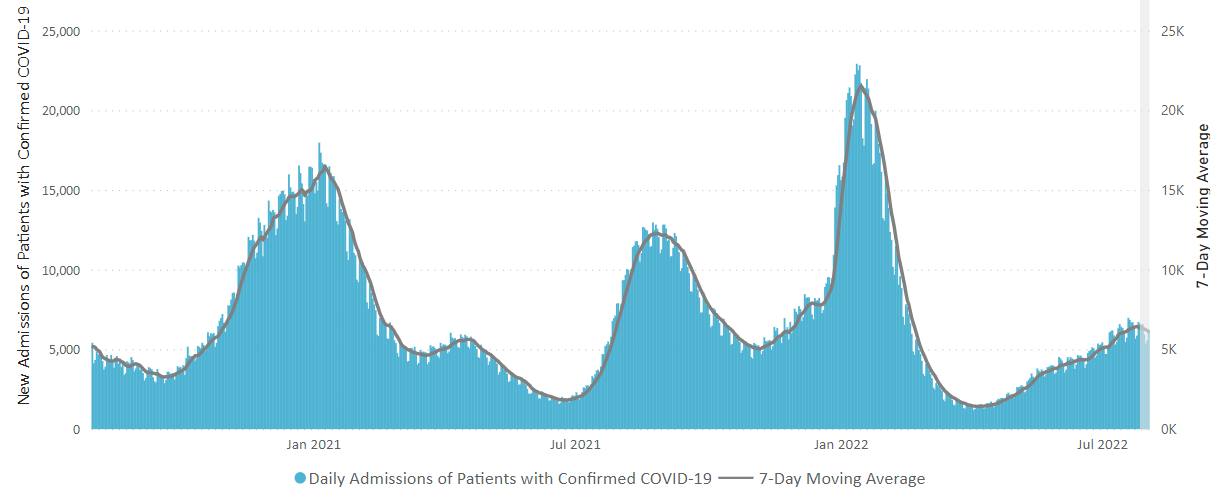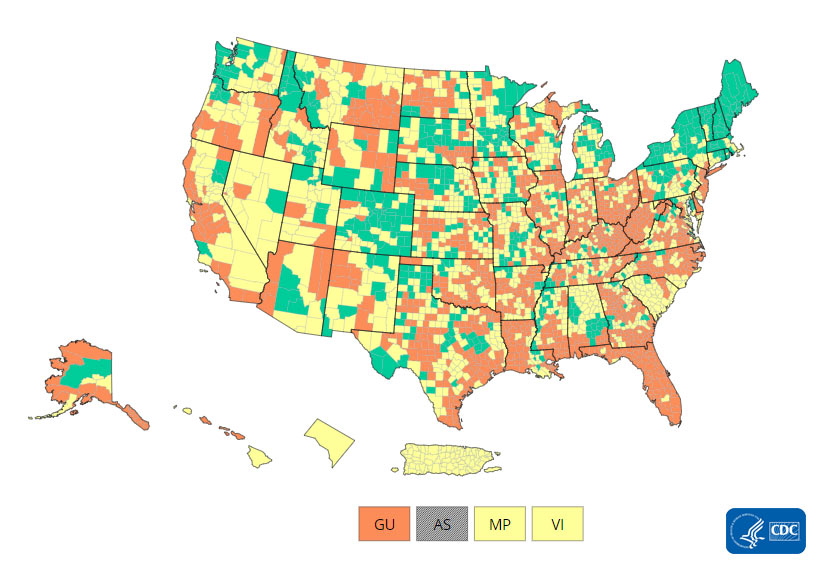Recommendations for Fully Vaccinated People
COVID-19 Homepage
Help is Here
Interpretive Summary for August 5, 2022
Help is Here
Last week’s COVID Data Tracker Weekly Review focused on the mental health concerns of public health workers during the COVID-19 pandemic. Many people have been struggling for the past two years, whether it be from illness, deaths of loved ones, economic hardship, disrupted education, or any of the many stressors that the pandemic has introduced to the world. Unfortunately, children and adolescents are no exception. Pre-pandemic data showed significant increases in mental health symptoms among U.S. high school students during the decade before COVID-19, and an April 2022 CDC report found that this crisis has continued during the pandemic.
According to the report, more than a third of high school students reported poor mental health during the pandemic, and almost half said they had felt persistently sad or hopeless during the past year. Students who didn’t feel close to anyone at school had higher rates of poor mental health, and the same held true for students who hadn’t been virtually connected to others during the pandemic.
However, there are many resources available to help children and their families start a conversation and help navigate through a mental health struggle. CDC’s How Right Now online guide can help kids identify how they’re feeling at any given moment and points them to resources for handling emotions like fear, grief, anger, and sadness. It has links to advice, hotlines, and support groups. There’s also a section with ideas for practicing gratitude, which is a great way to reduce stress and boost your physical and emotional well-being.
If you or your teen need immediate mental health support, call 988 for the National Suicide Prevention LifelineExternal or use the lifeline chatExternal to connect with a trained crisis counselor.
- COVID Data Tracker’s Vaccinations in the US tab was updated to include Novavax data.
- Interim Recommendation of the Advisory Committee on Immunization Practices for Use of the Novavax COVID-19 Vaccine in Persons Aged ≥18 years — United States, July 2022
- Post–COVID-19 Symptoms and Conditions Among Children and Adolescents — United States, March 1, 2020–January 31, 2022
- Notes from the Field: Increase in Pediatric Intracranial Infections During the COVID-19 Pandemic — Eight Pediatric Hospitals, United States, March 2020–March 2022
COVID-19 Community Levels
As of August 4, 2022, there are 1,343 (41.7%) counties, districts, or territories with a high COVID-19 Community Level, 1,252 (38.9%) counties with a medium Community Level, and 625 (19.4%) counties with a low Community Level. Compared with last week, this represents a moderate decrease (−4.09 percentage points) in the number of high-level counties, a moderate increase (+3.38 percentage points) in the number of medium-level counties, and a small increase (+0.71 percentage points) in the number of low-level counties. Overall, 50 out of 52 jurisdictions* had high- or medium-level counties this week. Maine and New Hampshire are the only jurisdictions to have all counties at low Community Levels.
To check your COVID-19 Community Level, visit COVID Data Tracker. To learn which prevention measures are recommended based on your COVID-19 Community Level, visit COVID-19 Community Level and COVID-19 Prevention.
*Includes the 50 states, the District of Columbia, and U.S. territories.
Reported Cases
As of August 3, 2022, the current 7-day moving average of daily new cases (117,351) decreased 7.3% compared with the previous 7-day moving average (126,537). A total of 91,676,264 COVID-19 cases have been reported in the United States as of August 3, 2022.
Variant Proportions
CDC Nowcast projections* for the week ending July 30, 2022, estimate that the combined national proportion of lineages designated as Omicron will continue to be 100% with the predominant Omicron lineage being BA.5, projected at 85.5% (95% PI 83.8-87.0%).
There are several lineages of Omicron and within each are multiple sublineages. The national proportion of BA.4 is projected to be 7.7% (95% PI 7.0-8.5%), BA.4.6 is projected to be 4.1% (95% PI 3.2-5.4%), BA.2.12.1 is projected to be 2.6% (95% PI 2.4-2.8%), and BA.2 is projected to be 0.1% (95% PI 0.1-0.1%). See COVID Data Tracker for current data.
91,676,264
Total Cases Reported
91,676,264
Total Cases Reported
117,351
Current 7-Day Average**
117,351
Current 7-Day Average**
126,537
Prior 7-Day Average
126,537
Prior 7-Day Average
-7.3%
Change in 7-Day Average since Prior Week
-7.3%
Change in 7-Day Average since Prior Week
*The median time from specimen collection to sequence data reporting is about 3 weeks. As a result, weighted estimates for the most recent few weeks may be unstable or unavailable. CDC’s Nowcast is a data projection tool that helps fill this gap by generating timely estimates of variant proportions for variants that are circulating in the United States. View Nowcast estimates on CDC’s COVID Data Tracker website on the Variant Proportions page.
**Historical cases are excluded from daily new cases and 7-day average calculations until they are incorporated into the dataset for the applicable date. Of 652,812 historical cases reported retroactively, 92,150 were reported in the current week and 24,310 were reported in the prior week.
Vaccinations
The U.S. COVID-19 Vaccination Program began December 14, 2020. As of August 3, 2022, 604.2 million vaccine doses have been administered in the United States. Overall, about 261.6 million people, or 78.8% of the total U.S. population, have received at least one dose of vaccine. About 223.0 million people, or 67.2% of the total U.S. population, have been fully vaccinated.* Of those fully vaccinated, about 107.5 million people have received a booster dose,** but 50.0% of the total booster-eligible population has not yet received a booster dose.
CDC’s COVID Data Tracker displays vaccination trends by age group, race/ethnicity, and urban/rural status. To see trends by age group and race/ethnicity, visit the Vaccination Demographic Trends tab. To see trends by urban/rural status, visit the COVID-19 Vaccination Equity tab.
604,235,972
Vaccine Doses Administered
604,235,972
Vaccine Doses Administered
261,591,248
People who received at least one dose
261,591,248
People who received at least one dose
223,035,566
People who are fully vaccinated*
223,035,566
People who are fully vaccinated*
78.8%
Percentage of the U.S. population who have received at least one dose
78.8%
Percentage of the U.S. population who have received at least one dose
67.2%
Percentage of the U.S. population who have been fully vaccinated*
67.2%
Percentage of the U.S. population who have been fully vaccinated*
+0.0
Percentage point increase from last week
+0.0
Percentage point increase from last week
+0.0
Percentage point change from last week
+0.0
Percentage point change from last week
*Represents the number of people who have received the second dose in a two-dose COVID-19 vaccine series (such as the Pfizer-BioNTech, Moderna, or Novavax vaccines) or one dose of the single-shot Johnson & Johnson’s Janssen vaccine.
**Represents the number of people who are fully vaccinated and have received another dose of COVID-19 vaccine since August 13, 2021. This includes people who received their first additional dose or booster dose.
Hospitalizations
New Hospital Admissions
The current 7-day daily average for July 27–August 2, 2022, was 6,112. This is a 4.4% decrease from the prior 7-day average (6,396) from July 20–26, 2022.
5,078,893
Total New Admissions
5,078,893
Total New Admissions
6,112
Current 7-Day Average
6,112
Current 7-Day Average
6,396
Prior 7-Day Average
6,396
Prior 7-Day Average
-4.4%
Change in 7-Day Average
-4.4%
Change in 7-Day Average
The start of consistent reporting of hospital admissions data was August 1, 2020.
Daily Trends in Number of New COVID-19 Hospital Admissions in the United States

New admissions are pulled from a 10 am EDT snapshot of the HHS Unified Hospital Data – Analytic Dataset. Due to potential reporting delays, data from the most recent 7 days, as noted in the figure above with the grey bar, should be interpreted with caution. Small shifts in historic data may also occur due to changes in the Centers for Medicare & Medicaid Services (CMS) Provider of Services file, which is used to identify the cohort of included hospitals.
COVID-NET: Trends in COVID-19-Associated Hospitalizations among Children Ages 6 Months and Younger
CDC’s Coronavirus Disease 2019-Associated Hospitalization Surveillance Network (COVID-NET) shows that for the week ending July 16, the rate of COVID-19-associated hospitalizations (per 100,000 population) for children ages 6 months and younger, who are not eligible for vaccination, is 26.0, more than 10 times the rate of 2.0 for the week ending April 9. While the weekly rate of hospitalizations for all age groups have increased since April, the rates for children ages 6 months and younger are highest among all pediatric age groups.
Trends in COVID-19-Associated Hospitalizations among Adults Ages ≥65 Years

The Coronavirus Disease 2019 (COVID-19)-Associated Hospitalization Surveillance Network (COVID-NET) is an additional source for hospitalization data collected through a network of more than 250 acute-care hospitals in 14 states (representing ~10% of the U.S. population). Detailed data on patient demographics, including race/ethnicity, underlying medical conditions, medical interventions, and clinical outcomes, are collected using a standardized case reporting form.
Deaths
The current 7-day moving average of new deaths (378) has decreased 4.9% compared with the previous 7-day moving average (397). As of August 3, 2022, a total of 1,027,370 COVID-19 deaths have been reported in the United States.
1,027,370
Total Deaths Reported
1,027,370
Total Deaths Reported
378
Current 7-Day Average*
378
Current 7-Day Average*
397
Prior 7-Day Average
397
Prior 7-Day Average
-4.9%
Change in 7-Day Average Since Prior Week
-4.9%
Change in 7-Day Average Since Prior Week
*Historical deaths are excluded from the daily new deaths and 7-day average calculations until they are incorporated into the dataset by their applicable date. Of 21,756 historical deaths reported retroactively, none were reported in the current week; and none were reported in the prior week.
Daily Trends in Number of COVID-19 Deaths in the United States Reported to CDC

7-Day moving average
 More Death Data
More Death DataTesting
The percentage of COVID-19 NAATs (nucleic acid amplification tests)* that are positive is decreasing in comparison to the previous week. The 7-day average of percent positivity from NAATs is now 18.1%. The 7-day average number of tests reported for July 22–28, 2022, was 500,250, down 11.4% from 564,487 for the prior 7 days.
933,467,627
Total Tests Reported
933,467,627
Total Tests Reported
500,250
7-Day Average Tests Reported
500,250
7-Day Average Tests Reported
18.1%
7-Day Average % Positivity
18.1%
7-Day Average % Positivity
18.5%
Previous 7-Day Average % Positivity
18.5%
Previous 7-Day Average % Positivity
-0.47
Percentage point change in 7-Day Average % Positivity since Prior Week
-0.47
Percentage point change in 7-Day Average % Positivity since Prior Week
*Test for SARS-CoV-2, the virus that causes COVID-19
Wastewater Surveillance
COVID Data Tracker’s Wastewater Surveillance tab tracks levels, changes, and detections of SARS-CoV-2* viral RNA in wastewater at over 1,000 testing sites across the country.
Currently, most of the country is reporting moderate to high SARS-CoV-2 levels in wastewater. About half of sites reporting wastewater data are currently seeing some of the highest levels for those sites since December 1, 2021. About half of sites are experiencing a decrease in SARS-CoV-2 levels, and about 40% are reporting an increase. It’s important to note that even a small increase when levels are low can appear like a dramatic increase in the percent change.
For more information on how to use wastewater data visit CDC’s website.
*The virus that causes COVID-19
SARS-CoV-2 Levels in Wastewater by Site


0% means levels are the lowest they have been at the site; 100% means levels are the highest they have been at the site.






